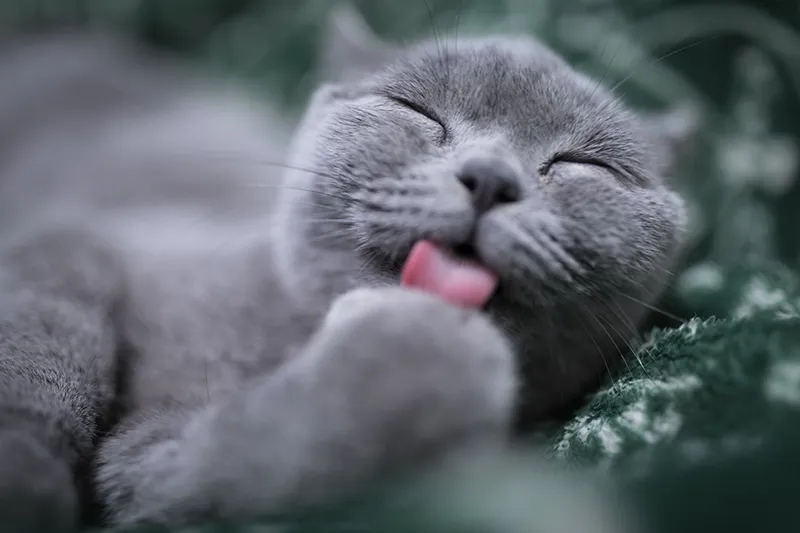
How common is dental disease in cats?
Dental disease is one of the most common medical conditions seen by veterinarians. More than half of all cats over the age of three have some form of dental disease. The most common problems are gingivitis (inflammation of the gums caused by the accumulation of plaque), periodontal disease (a progression from gingivitis), and tooth resorption (formerly called feline oral resorptive lesions or cervical neck lesions).
What are the clinical signs of dental disease?
Many cats do not display signs of dental disease that their owners can detect. Complete oral examination under general anesthetic with intraoral radiographs (X-rays) to detect hidden disease is required beginning very early in your cat’s life. If your cat does show signs, they may include pawing at her mouth, head shaking, or jaw chattering. She may chew with obvious discomfort, drop food from her mouth, swallow with difficulty, or drool excessively. The saliva may contain blood. Halitosis (bad breath) is also common.
“Dental disease and oral pain may account for some cats’ finicky appetites.”
Dental disease and oral pain may account for some cats’ finicky appetites. Many cats will refuse dry food or swallow it whole (no chewing) and demonstrate a preference for moist or canned foods. Some cats will have a decreased interest in food or may hesitantly approach their food bowl with reluctance to eat. This may lead to noticeable weight loss.
What are the most common dental diseases in cats?
The most common dental diseases in cats are periodontal disease and tooth resorption.
Periodontal disease is a term used to describe infection and associated inflammation of the periodontium (the tissues surrounding the tooth). Four tissues comprise the periodontium: the gingiva, the cementum (covering the root surface), the periodontal ligament (attaching the tooth root to the bone), and the alveolar bone.
Periodontal disease starts with gingivitis (with early inflammation of the gums). Gingivitis results from plaque (bacterial slime) that accumulates on the tooth surfaces and contacts the gingiva. Plaque is a biofilm and home to many thousands of bacteria. Some of this plaque is naturally removed during eating or by the cat’s tongue. However, plaque quickly builds without daily brushing and eventually (over 36-48 hours) mineralizes, forming hard tartar (also called calculus). Tartar has a rough surface to which plaque can “stick” more readily. Untreated gingivitis may lead to further inflammation of the other tissues of the periodontium. Progression of the periodontal disease leads to loss of tooth support and loss of the tooth.
“Progression of the periodontal disease leads to loss of tooth support and loss of the tooth.”
There may be other consequences of periodontal disease due to the loss of bone, including oronasal fistula (a hole from the mouth into the nose), jaw fracture, abscessation with draining tracts that develop in the mouth, on the face, or under the chin. Some studies indicate that the bacteria from a severe oral disease, which gets into the bloodstream, may also be associated with pathological changes in major organs, such as the heart, liver, and kidney.
What is tooth resorption?
Tooth resorption is the progressive destruction of the tooth (crown and root), resulting in slowly progressive “holes” in the affected teeth. Once sensitive parts of the tooth are exposed, these lesions become intensely painful, and the only effective and humane treatment is to extract the tooth. While the cause of this disease is unknown, poor oral hygiene can play a role in the disease process (see the handout called “Tooth Resorption in Cats” for further details).
Is gingivitis always associated with dental disease?

As teeth erupt, there is an increased redness in the gums, and this is known as eruption gingivitis. This should resolve as development progresses.
Some cats, however, develop severe oral inflammation called stomatitis. This is a complex condition for which no specific cause has been identified. It is believed that cats who develop this disease have an extreme reaction to oral bacteria and plaque. The degree and extent of the ensuing inflammation can be excruciating, significantly lower the cat’s quality of life, and cause intense distress for the cat and her owner.
Treatment involves a detailed oral evaluation under general anesthetic, with intraoral radiographs and the extraction of any teeth affected with periodontitis, along with a thorough periodontal cleaning of the remaining healthy teeth. Afterward, various forms of therapy that combine medications, such as anti-inflammatories, antibiotics, or immunomodulators, and oral home care are instituted. Each cat is different, and medication choices can vary depending on the individual cat’s response. Studies have shown that up to 60% of cats can have their disease significantly decreased or even resolved, while 40% continue to struggle with varying degrees of oral inflammation.
Stomatitis cases are best referred to a board-certified veterinary dentist who can tailor therapy to the individual cat.
What should I do if my cat shows signs of dental problems?
Suppose you see evidence of tartar accumulation or gingivitis, or your cat exhibits signs of mouth pain or discomfort. In these cases, you should take her to your veterinarian for an oral examination. You will be advised on the most appropriate course of treatment, which may involve having your cat’s teeth examined, professionally cleaned, and radiographed under general anesthesia.
The rate of tartar accumulation is highly variable between individual cats, and in some cases, this may require professional cleaning every 6-12 months. Your veterinarian will help you assess the frequency suitable for your cat.
“Do not try to remove tartar from the teeth yourself with any form of metallic instrument.”
Do not try to remove tartar from the teeth yourself with any form of metallic instrument. Aside from potentially harming your cat’s mouth or her harming you, you may damage the tooth’s surface by creating microscopic scratches. These scratches allow bacteria to cling to and encourage faster plaque formation, which only worsens the problem. Maintaining a smooth tooth surface is essential and is why your human dental hygienist always polishes your teeth after removing tartar with dental instruments.
What can I do to help prevent dental disease in my cat?
The best way to prevent dental disease is to reduce the rate at which plaque and tartar build up on her teeth. Recent advances in pet nutrition have resulted in the development of water additives, treats, and kibble diets that can reduce tartar accumulation. The Veterinary Oral Health Council seal of acceptance (VOHC.org) will only be found on products that reduce the accumulation of plaque and tartar. Please look for this seal when choosing oral care products for your cat.
“The most effective way to reduce plaque and tartar is to brush your cat’s teeth daily.”
The most effective way to reduce plaque and tartar is to brush your cat’s teeth daily (see the handout “Brushing Your Cat’s Teeth” for more information). Several toothbrushes are designed for a cat’s mouth. Never use human toothpaste. Human toothpastes are foaming products and contain ingredients that should not be swallowed, as they could cause internal problems. Use pet toothpaste that is non-foaming and safe to be swallowed—they are available in flavors your cat will find appealing.
Rubbing cotton swabs (i.e., Q-tip®) dipped in tuna juice on your cat’s teeth is good to help train your cat to accept toothbrushing. While the tuna juice has no beneficial dental cleaning effects, it helps your cat positively associate the tuna juice and the toothbrushing experience. Ask your veterinarian for advice about dental products for your cat.
With a gentle approach, patience, and perseverance, it is possible to brush your cat’s teeth and provide the oral care needed to prevent dental disease.
HEAL Veterinary Hospital
25 Jay Street
Brooklyn, NY, 11206
t: 929-359-9297
Also serving Dumbo Brooklyn, NY and surrounding areas.
Business Hours
Monday-Friday: 9am–5pm
Saturday: 9am–3pm


